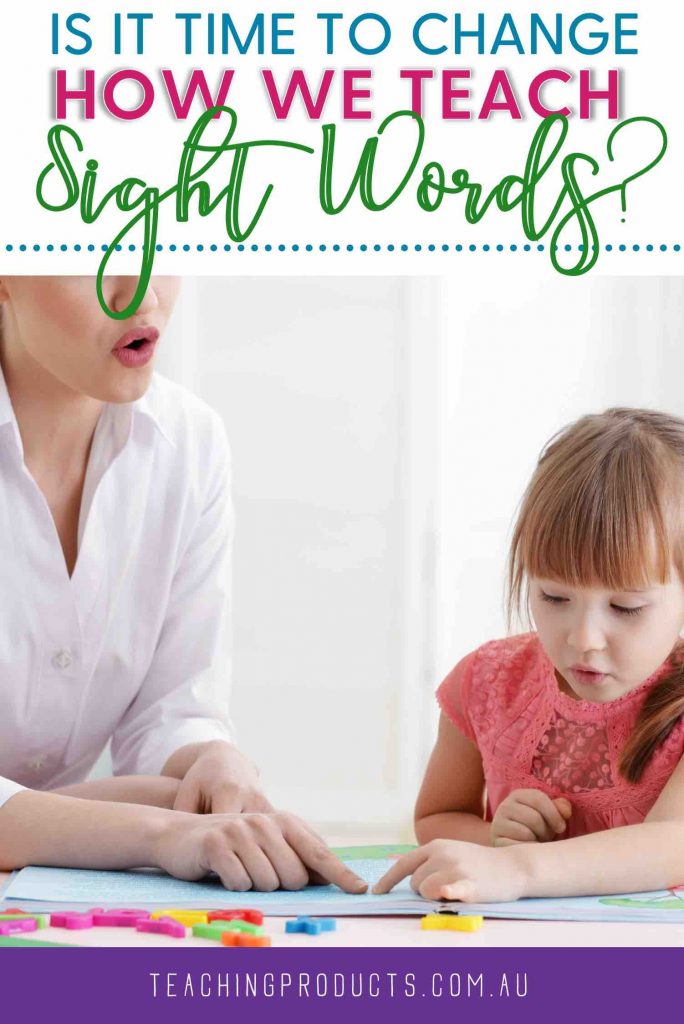In this post, I’ll be sharing my opinion about high-frequency words (sight words), and how children learn to read.
This content may contain affiliate links. Please read my disclosure policy to learn more about this.

My son started school a few weeks ago and, after his third day, he bounded out of his classroom, proudly waving a notebook in front of my face. He told me it was his ‘sight word book’ and that he needed to learn the eight words listed inside.
But He Doesn’t Know Many Letters Yet
My first thought at the sight of this book was that he doesn’t know any letters or sounds yet. This little 5-year-old bouncing giddily in front of me knew the letters of his first name. That was it. Four simple letters and he struggled to make the sound of each. Yet he’s expected to learn to ‘read’ a list of eight seemingly random words. The words are clearly taken from one of the most commonly used lists of sight words, and once these 8 words were mastered, he’d receive a new list of words.
And Therein Lies The Problem
I remember learning about sight words when I was studying to become a teacher. Some textbooks referred to them as ‘high-frequency words’, while others called them ‘sight words’. I was taught that the words on these lists are not decodable and therefore children need to recognize the words by sight (hence the term ‘sight word’). To me, the term ‘sight word’ is the beginning of the problem. This implies that children are expected to ‘read’ these words by sight, almost like it’s an image. Using ‘high-frequency’ words instead (or, even better, use ‘orthographically mapped’ words) helps reduce this confusion.
This Is Not Reading
Teaching children to ‘read’ sight words is not teaching them to read. It’s teaching them to identify the image of the word. The shape, or the pattern that the squiggly lines all make together. These words are often taught with no context to make them meaningful.
The Second Problem I Have With Sight Word Lists
Have you ever looked at how old these lists are? Some of them are old. Like really really old. Dolch’s lists were first created in 1936, and published in 1948. Now 1936 may not seem that long ago (after all, you probably know someone that was alive then, right?!) but I wouldn’t be far off in saying it was almost one hundred years ago. Now Fry’s word lists were developed in the 1950s and updated in 1980, so they’re a little more recent (but still 40 years old).
So What’s Changed?
A lot has changed since then. Let’s reflect on technological advances. Step back in time to 1980 and have a conversation with someone about tablets and they’ll think you’re talking about medication. Mention the internet and they’ll look at you like you’ve suddenly sprouted three heads. Our language has changed in a similar way. English is a ‘living’ language, meaning it continues to be used and is still evolving.
But Why Does This Matter?
Some of the words on these word lists aren’t commonly used anymore. Think about your top five picture books – do any of them include the word ‘shall’? These word lists were developed to provide the most commonly used words in children’s literature, however, the way we use words (and the words we use) has changed a lot over the past 100 years. Many of the words are now obsolete, and other words have become more common.
Some Lists Are More Recent
The Oxford list (commonly used in Australian classrooms) has done a better job of keeping up – first released in 2007 and updated in 2017. They’ve even conducted research into the different ways language is used based on gender, race, socio-economic status, and geographical location.
So What’s The Problem?
The problem still remains that teachers are taught to teach children to identify these words by sight. Children are being taught the image of the word, rather than how to read the word. Many educators believe that many of the words on these lists are not decodable, therefore children need to learn them by sight. But, when you see words like ‘did’ or ‘and’ on the list, you start to wonder why these words are included. I struggle to see how a lot of these words are not decodable – sure, some of them aren’t. But a lot are. And children should be taught to decode these words. Take ‘and’ for example – three clear sounds /a/n/d/ yet it’s commonly one of the first ten words included on these lists.
What Does The Research Say?
To put it simply, the research shows that our knowledge of the brain, and how children learn to read, has made significant gains in the past 20 years, however, our teaching practices remain largely unchanged. A peek into many early years classrooms today shows a cueing system with reading strategies like ‘stretch out the word’, ‘use the picture’, or ‘eagle eyes’. These dated strategies are actually the strategies that struggling readers use. These are the strategies that children use to ‘fake it’. They look like they’re reading, but they’re really not. Don’t stress if you teach these strategies in your classroom – I used to teach them too. Before I knew better. And when you know better, you do better. If you want more information about the research and the science of reading, then take a look at the work of David Kilpatrick.
So How Should We Teach Children To Read?
There are six basic steps to teaching children to read: Oral Language, Phonemic Awareness, Phonics, Fluency, Vocabulary, and Comprehension. Start with the basics – phonological awareness, phonemic awareness, and phonics. Build a solid foundation in these. Teach children the letter sounds. Play word games, practice manipulating sounds and read CVC (consonant-vowel-consonant) words such as cat, dog, him. Put decodable readers in their hands.
Once children have a solid grasp of these skills, then begin to introduce more common phonemes that use two letters (for example, sh, ch, th). By this stage, your students should be able to readily read many of the words on these word lists (after all, many of those words are decodable). And I mean read, not just recognize the shape or pattern of the word. If you need to teach high-frequency words (because your administration says you must) then teach them in a phonics-based order (either spelling or sound) to make learning more efficient. Your students will also be able to apply their phonemic knowledge to the trickier words on these lists because you will have explicitly taught your students how to decipher the code of irregular spelling patterns. Add text knowledge and writing to this and you’ve got yourself a well-rounded, evidence-based literacy program.




Thanks for this! Now I don’t feel so bad for not putting much emphasis on sight words. 🙂